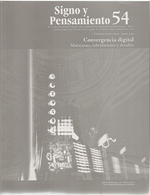Abstract
Numerous concepts have been developed to describe the convergence of languages within contemporary media systems. This paper purports a theoretical reflection on the so-called rhetorical or semiotic convergence, a specific convergence that runs parallel to economic and technological developments. After inspecting the conceptual chaos that surrounds the concept, we examine herein how languages are contaminated thus generating hybrid spaces in the production of meaning. Finally, we propose a complementary approach based on the concept of difference or divergence.
— (1986), Estética de la poética en Dostoievski, México, Fondo de Cultura Económica.
Bettetini, G. y Colombo, F. (eds.) (1993), Le nuove tecnologie della comunicazione, Milán, Bompiani.
Bolter, J. D. (1991), Writing Space: The Computer, Hypertext, and the History of Writing, Hillsdale (nj), Lawrence Erlbaum Associates Publishers.
Bolter, J. D. y Grusin, R. (2000), Remediation. Understanding New Media, Cambridge (MA), MIT Press.
Eco, U. (1979), Lector in fabula, Milán, Bompiani.
— (2003), Dire la stessa cosa, Milán, Bompiani.
Fagerjord, A. (2003), “Rhetorical Convergence. Studying Web Media”, en: Liestøl, G.; Morrison, A., y Rasmussen, T. (eds.), Digital Media Revisited. Theoretical and Conceptual Innovation in Digital Domains, Cambridge (MA), mit Press.
Fidler, R. (1998), Mediamorfosis. Comprender los nuevos medios, Buenos Aires, Granica.
García Canclini, N. (2007), Lectores, espectadores e internautas, Barcelona, Gedisa.
Greimas, A. y Courtés, J. (1979), Semiótica. Diccionario razonado de la teoría del lenguaje, Madrid, Gredos.
Jakobson, R. (1985), Ensayos de lingüística general, Barcelona, Planeta. Kristeva, J. (1978), Semiótica, vol. I, Madrid, Espiral-Fundamentos.
Marshall, D. (2004), New Media Cultures, Londres, Arnold Publishers. Miller, V. (2004), “Stitching the Web into Global Capitalism: Two Stories”, en: Gauntlett, D. y Horsley, R. (eds.), Web Studies, 2. a ed., Londres, Arnold.
Negroponte, N. (1995), El mundo digital, Barcelona, Ediciones B. Salaverría, R. (2003), “Convergencia de medios”, en Chasqui [en línea], núm. 81, disponible en: http://chasqui.comunica.org/content/view/190/64/.
Scolari, C. (2004), Hacer clic. Hacia una sociosemiótica de las interacciones digitales, Barcelona, Gedisa.
— (2008a), Hipermediaciones. Elementos para una teoría de la comunicación digital interactiva, Barcelona, Gedisa.
— (2008b), “Hacia la hipertelevisión. Los primeros síntomas de una nueva configuración del dispositivo televisivo” [en línea], en Diálogos de la Comunicación, núm. 77, disponible en: http://www.dialogosfelafacs.net/77/articulos/ pdf/77CarlosScolari.pdf
Scolari, C.; Navarro, H.; Pardo, H.; Micó, J., y Coll, I. (2006a), “Nous perfils professionals de l’actual panorama informatiu audiovisual i multimèdia de Catalunya” [informe de investigación presentado al Consell de l’Audiovisual de Catalunya], Barcelona, disponible en: http://www.portalcomunicacion.com/cat/dest_perfil.html.
Scolari, C.; Jarque, J., y Perales, C. (2007), El canvi digital als mitjans de proximitat, Barcelona, Generalitat de Catalunya/acpc.
Todorov, T. (2004), Teoría de la literatura de los formalistas rusos, Buenos Aires, Siglo XXI.
This journal is registered under a Creative Commons Attribution 4.0 International Public License. Thus, this work may be reproduced, distributed, and publicly shared in digital format, as long as the names of the authors and Pontificia Universidad Javeriana are acknowledged. Others are allowed to quote, adapt, transform, auto-archive, republish, and create based on this material, for any purpose (even commercial ones), provided the authorship is duly acknowledged, a link to the original work is provided, and it is specified if changes have been made. Pontificia Universidad Javeriana does not hold the rights of published works and the authors are solely responsible for the contents of their works; they keep the moral, intellectual, privacy, and publicity rights.
Approving the intervention of the work (review, copy-editing, translation, layout) and the following outreach, are granted through an use license and not through an assignment of rights. This means the journal and Pontificia Universidad Javeriana cannot be held responsible for any ethical malpractice by the authors. As a consequence of the protection granted by the use license, the journal is not required to publish recantations or modify information already published, unless the errata stems from the editorial management process. Publishing contents in this journal does not generate royalties for contributors.


